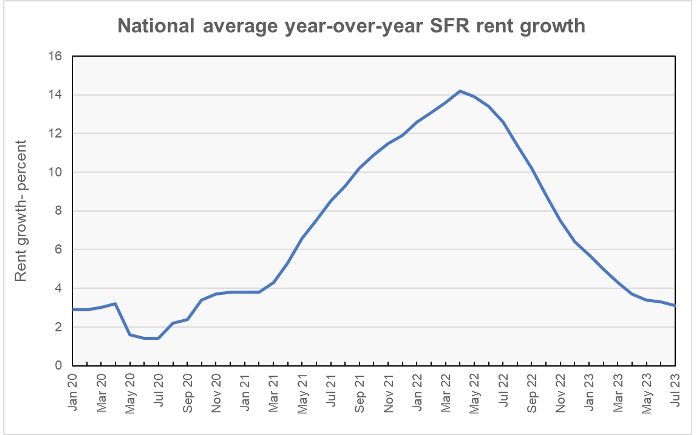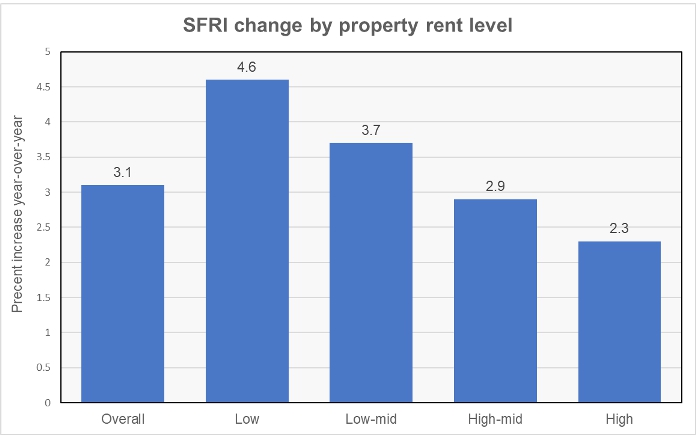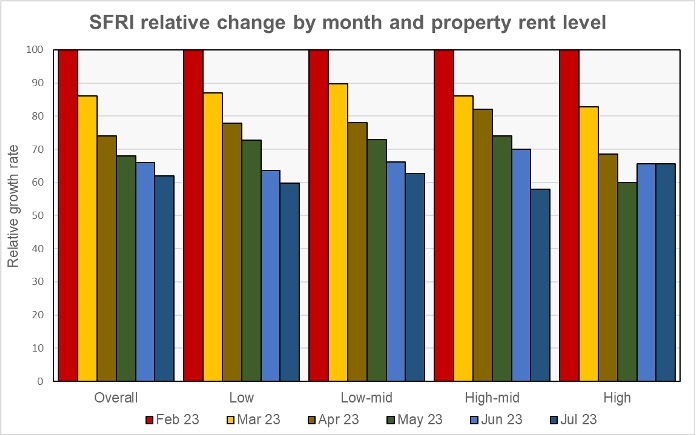CoreLogic reported that their single-family rent index (SFRI) for July rose 3.1 percent from its year-earlier level. This is down from the 3.3 percent year-over-year SFR rent growth reported last month. The rate of year-over-year growth in the SFRI has been declining steadily since reaching a recent peak in April 2022.
Visualizing national trends
The history of the overall SFRI since January 2020 is shown in the first chart, below.

The chart shows that the rate of growth in single-family rents seems to be settling into a new normal which is very close to the pre-pandemic normal.
For comparison, Yardi Matrix found that single-family rent growth in July was 1.2 percent year-over-year. However, Yardi Matrix focuses on properties of 50 or more units while CoreLogic takes a broader look at the single-family rental market.
Different tiers, different rates
In addition to the overall SFRI, CoreLogic calculates SFR rent growth by the relative asking rent for the properties it covers. It divides the properties into 4 groups: those priced at 75 percent or less than the regional median (Low), those priced at 75 to 100 percent of regional median (Low-mid), those priced at 100 to 125 percent of regional median (High-mid) and those priced above 125 percent of regional median. The results for July 2023 are shown in the next chart, below.

The chart shows that SFR rent growth is higher for lower priced properties. It progressively declines for each higher price tier.
The last chart shows the relative rate of decline in SFR rent growth over the last 6 months by rent tier. Each cluster of bars shows the ratio of the rates of rent growth measured for that property rent tier for the last 6 months compared to its level 6 months ago. It shows that the highest relative rent decline over the last six months is for the high-mid properties at 42 percent. The lowest relative rent decline is for high-priced properties at 34 percent.

Looking at metros
CoreLogic reports the year-over-year rate of growth in the SFRI for a select group of metropolitan areas. St. Louis rose to the top of this list from fifth place last month. It recorded SFR rent growth of 7.3 percent in July, up from only 5.2 percent last month. Chicago dropped to second place as its rent growth fell to 6.3 percent from 6.6 percent last month. Boston (5.7 percent), San Diego (5.7 percent) and New York (4.9 percent) round out the top 5 metros.
Three of the metros listed saw SFR rents decline. They are Las Vegas (-1.0 percent), Miami (-0.6 percent) and Austin (-0.6 percent).
CoreLogic is a data and analytics company. It calculates the SFRI using “a repeat pairing methodology to single-family rental listing data in the Multiple Listing Service.” The CoreLogic report is available here.













